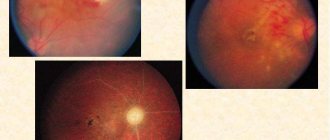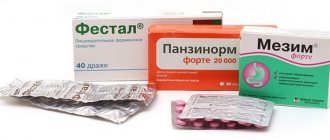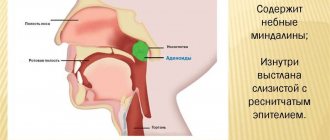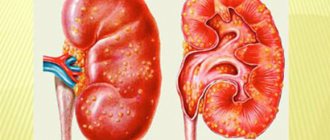Description of the disease
Thrombophlebitis is an inflammatory process that develops in the walls of veins and is often accompanied by the formation of blood clots. As a rule, the disease develops in older people, but recently the disease is increasingly being diagnosed in young people. The main danger of the pathology is the formation of a blood clot. This is a relatively small blood clot that can break off at any time. If this happens, the likelihood of blockage of some veins and arteries increases several times, which often ends in death.
Causes and risk factors
The main causes of thrombophlebitis are combined changes in the intensity of blood flow in the veins against the background of weakness of the walls and increasing pressure in them. As a result of these phenomena, blood flow slows down and blood clots form, which settle on the walls of the veins. Various factors can provoke the inflammatory process:
- varicose veins;
- vascular injuries (including puncture by a needle during injection) and surgical interventions;
- systemic infections and inflammatory processes in internal organs;
- hormonal changes;
- the presence of malignant tumors in the body.
Thrombophlebitis occurs very often during pregnancy and immediately after childbirth. The problem is that pregnant women combine several factors that affect the condition of blood vessels. Firstly, hormonal changes occur in their body, and in the second and third trimester, the blood becomes more viscous, prone to the formation of blood clots. Secondly, the load on the body (and especially on the lower limbs) increases, as a result of which varicose veins worsen. Thirdly, the body becomes unstable to infections.
Thrombophlebitis in the postpartum period is often caused by increased stress during pushing.
Many patients with this diagnosis do not suspect the dangers of thrombophlebitis. In addition to the detachment of a blood clot or complete closure of the lumen of the vein, it can be complicated by PTF - a disease that stands for postthrombophlenic syndrome. It develops with low-grade inflammation and represents an irreversible change in the vessel wall with the replacement of normal endothelium by connective tissue. As a result, the vein is completely transformed into a tube with atrophied valves and a strand of connective tissue around it.
Types of thrombophlebitis
The official classification of the disease distinguishes several of its groups, which differ in the origin and localization of the inflammatory process, the course of the disease, the area affected and other features.
According to the affected area, pathology is divided into the following types:
- deep thrombophlebitis - inflammation of a deep-lying vessel, most often on the thigh or in internal organs;
- superficial thrombophlebitis - inflammation of a vessel located in close proximity to the skin, most often found in the veins of the lower extremities.
When considering the affected area, venous thrombophlebitis is divided into the following types:
- local thrombophlebitis - inflammation that occurs at the site of attachment of the blood clot and is accompanied by localized symptoms (neck, lower extremities, back, etc.);
- migrating thrombophlebitis is an inflammation that, when it subsides in one place, moves to another part of the vein and is characterized by rapid progression.
Depending on the reasons for the formation of a blood clot and the occurrence of the inflammatory process, the following types of disease are distinguished:
- varicothrombophlebitis - inflammation that occurs against the background of varicose veins;
- post-injection thrombophlebitis - an inflammatory process that occurs at the site of a puncture of the vein wall;
- infectious or septic - postoperative, postpartum or erysipelas, in which pathogenic flora is detected in the pathological focus;
- aseptic - inflammation that occurs in the absence of a bacterial component.
In addition, thrombophlebitis is divided into acute and chronic. In its acute course, the disease is accompanied by severe symptoms that last up to a month. In contrast, chronic thrombophlebitis occurs cyclically: periods of absence of inflammation alternate with exacerbations. Symptoms in the chronic form of the disease are less pronounced than in the acute form. Phlebologists distinguish ascending thrombophlebitis into a separate subtype. This form of the disease refers to acute inflammation, but is characterized by rapid development and an increased risk of blood clot rupture.
Depending on the size of the blood clot that caused the inflammatory process, three types of disease are distinguished:
- occlusive, in which there is a blockage of the vessel with a significant slowdown in blood flow in it;
- ischemic, in which a blood clot and swelling in the area of inflammation lead to complete blockage of the vein, cessation of blood flow in it and the development of tissue necrosis;
- non-occlusive, in which a blood clot and swelling at the site of inflammation do not interfere with blood flow.
Any type and type of thrombophlebitis, if left untreated, can result in a condition known as post-thrombophlebic syndrome, in which the vessel completely loses function and the changes spread to surrounding tissues.
Classification
Depending on the location of the inflammatory process itself, the following are distinguished:
- Thrombophlebitis of the upper extremities.
- Damage to internal organs.
- Thrombophlebitis of the lower extremities.
The latter variant of the disease is recognized as the most common type of pathology. According to the nature of the lesion, acute and chronic forms of this disease are distinguished.
In addition, this pathology can affect not only deep/superficial veins, but also arteries.
Prevention of thrombophlebitis
In order to prevent the development of this disease, it is necessary to promptly eliminate the causes of its occurrence. First of all, this applies to people with varicose veins, a family history (close relatives suffer from varicose veins or thrombophlebitis), diabetes mellitus, obesity, and leading a sedentary lifestyle.
To prevent thrombophlebitis it is recommended:
- move more, walk, do therapeutic exercises;
- repeat a simple exercise every day up to 10 times a day: rise on your toes, and then sharply lower yourself onto your heels - it helps perfectly against stagnation of venous blood in the lower extremities;
- follow the rules of rational nutrition - this helps to normalize metabolism and reduce body weight, which, in turn, is the prevention of varicose veins and thrombophlebitis. You need to exclude sweets, confectionery, fatty meats, and fried foods from your diet. It is recommended to eat sea fish (preferably baked) 1-2 times a week, which contains a lot of Omega-3 fatty acids, which prevent the formation of blood clots;
- women suffering from varicose veins should be careful when taking oral contraceptives; they should definitely inform the gynecologist about the presence of the disease when selecting contraceptives;
- Persons suffering from varicose veins are recommended to wear compression knitwear - knee socks or tights. A doctor will help you choose them;
- Prevention of the progression of varicose veins and the development of thrombophlebitis is to strengthen the walls of the veins. For this purpose, venotonics are prescribed, for example, Detralex. It is taken 2 tablets per day with meals. Depending on the severity of varicose veins, prevention of thrombophlebitis can be carried out in courses of 6-8 weeks or continuously;
- among external agents to prevent the formation of blood clots, preparations based on heparin (gels Lyoton, Trombless, Lavenum) and troxerutin (gels Troxevasin, Troxerutin) are used;
- for varicose veins, as prescribed by a doctor, you can undergo courses of physiotherapeutic treatment several times a year: electro- or phonophoresis with medicinal solutions, darsonvalization, electrical stimulation, hyperbaric oxygenation (treatment in a pressure chamber), etc.;
- in the initial stages of varicose veins, sanatorium-resort treatment with water and mud procedures helps well. The resorts of Pyatigorsk and Kislovodsk are suitable.
Main reasons
The development of this disease is influenced by various factors. In some cases, doctors find it difficult to name the exact causes of this pathological process. For example, a decrease in immune defense and a weakened state of the body as a whole can cause such an unpleasant disease. However, the most common cause is considered to be varicose veins, as well as the so-called chronic venous insufficiency. A gradual change in the structure of the walls of blood vessels, disruption of normal blood flow - all these factors lead to inflammation of the walls of the veins and the formation of blood clots.
There are also other causes of thrombophlebitis:
- Mechanical injuries of the lower extremities.
- Genetic predisposition.
- Taking hormonal drugs.
- Bad habits.
- Oncology.
- Increased blood clotting.
- Allergy.
- Gynecological operations.
Etiological information
There are many causative factors, often a combination of several:
- infectious pathologies that cause inflammation in the vascular bed (influenza, furunculosis, typhus, erysipelas and tuberculosis, etc.);
- accompanying athologies (including bad habits) - neoplasms, alcoholism, tobacco dependence, drug addiction, allergic reaction, antiphospholipid syndrome, etc.;
- vascular injury due to blows, wounds, surgical manipulations;
- sudden changes in blood rheological parameters (thickness, coagulability, turbulence);
- slowing down blood flow (pathological processes in the body, taking hormone-based drugs);
- physical inactivity (occupational factor or lifestyle, prolonged bed rest);
- dehydration of the body;
- pressure on blood vessels due to excessive physical activity or a special physiological state of the body (sports, pregnancy, wearing high-heeled shoes, excess weight).
Who is at risk?
There are certain categories of people whom doctors classify as the so-called risk group. They are most likely to develop thrombophlebitis of the lower extremities. These include the following:
- People leading a sedentary lifestyle.
- Suffering from varicose veins.
- All those who have relatively recently undergone surgery and are forced to remain in bed for some time.
- Women in an “interesting” position.
- Overweight patients.
- Elderly people.
Symptoms
What signs indicate thrombophlebitis? This disease begins with severe pain in the legs. Its intensity may vary, but in any case it intensifies when walking. Patients also often note soreness of the skin when touched along the veins.
You may notice that the skin in the affected area has changed its color to red. After some time, the color turns blue and then brown. The temperature of this area is slightly higher compared to healthy areas.
The skin over the veins in which blood clots form becomes noticeably thicker. Very often, patients note an increase in body temperature, but literally after a week it returns to normal. A slight swelling of the leg appears. It is at this stage of the development of the disease that patients seek help from a doctor.
Thrombophlebitis and varicose veins
One of the common forms of the disease is the so-called varicose thrombophlebitis. It is accompanied by severe pain and characteristic redness of the skin. In this disease, the vein with the blood clot is surrounded by pronounced swelling. The main symptom of this form of the disease is severe painful discomfort during movement, as well as with any touch to the affected area. Some patients have a fever and a deterioration in their general condition, which resembles the symptoms of a common cold. Treatment in this case involves the use of anti-inflammatory drugs and hormonal ointments.
Thrombophlebitis in expectant mothers
Pregnancy is a period in a woman’s life when she has to deal with serious diseases, one of which is thrombophlebitis. The disease is explained by increased intrauterine pressure and physiological changes in blood composition. Superficial thrombophlebitis of the lower extremities poses its peak danger in the first days after childbirth, as it provokes serious overloads in the functioning of the vascular system itself. As a result, natural blood flow is disrupted and blood clots form.
The first precursors of the disease may appear in the second trimester, when the body weight of the expectant mother begins to actively increase. First, the appearance of so-called spider veins is noted, then the veins in the legs enlarge, and painful discomfort occurs. In the evening, your legs become increasingly swollen, and even cramps may appear. All of the above symptoms should be a reason to contact a phlebologist. After a full diagnostic examination, a specialist can give recommendations on how to prevent the transformation of the disease into more severe forms.
How to treat chronic thrombophlebitis
The main ways to treat chronic thrombophlebitis are conservative. They are supplemented by prevention, physical exercise and folk remedies.
Exercise and physical education
Therapeutic exercise helps saturate cells with nutrition and oxygen, normalize muscle tone, activate metabolism and blood flow, and prevent the formation of blood clots.
Exercises for thrombophlebitis of the lower extremities should be performed regularly and without overexertion. The basic movements are:
- rotation of the neck, shoulders;
- tilting the body down and to the sides;
- swinging movements of the arms;
- bending and straightening the legs at the knees in a lying position, simulating riding a bicycle, tucking the knees towards the stomach.
Preventive medication
For the purpose of prevention, medications are intended to maintain normal blood viscosity and improve venous tone. These include:
- blood thinners;
- heparin-based products;
- phlebotonics.
Do I need to follow a diet?
It is important for patients to adhere to a diet for chronic thrombophlebitis. It should be rich in products with a blood-thinning effect.
The diet during illness should be enriched with seafood, vegetables, berries and fruits, and cereals.
For thrombotic lesions of the veins, berry and herbal teas, infusions, and fruit drinks are useful. And strong and carbonated alcoholic drinks should be completely excluded.
Useful foods for thrombophlebitis
Do folk remedies help?
Treatment with folk remedies for chronic thrombophlebitis helps relieve or reduce the symptoms of the disease and serves as prevention. It can thin the blood, improve the tone of the veins, and relieve inflammation. Traditional medicine includes various mixtures and infusions of medicinal herbs. But they can only be used after consultation with a specialist.
Acute thrombophlebitis
Signs of the disease are most clearly manifested in the acute form of thrombophlebitis. Initially, patients note the appearance of pain along the entire direction of blood flow of the affected vein. Then there is a noticeable change in skin color in this area. As the body temperature rises, the leg becomes cold. At the first signs of an acute variant of the disease, it is recommended to immediately call a doctor. Until his arrival, you should stay in bed and not resort to self-treatment (rubbing in ointments, taking painkillers). The thing is that this approach can provoke the separation of the smallest fragment of a blood clot and its introduction into other systems of internal organs.
What is dangerous about acute thrombophlebitis? This disease very quickly develops into a complicated form (white/blue phlegmasia). It is usually accompanied by increasing pain. The skin first turns pale, then acquires a purple tint. This is why it is so important not to delay in obtaining qualified help.
Thrombophlebitis
Signs
Thrombophlebitis is dangerous and therefore requires immediate consultation with a doctor (surgeon, phlebologist) if you notice the following symptoms:
- hyperemia (redness) of the skin at the site of the altered vein (after about a week, the redness gives way to a bluish and then brown color as a result of changes in extravascular hemoglobin
- sharp pain when touched
- presence of a painful cord along the vein
- nagging pain in the veins that intensifies when walking
- along with the above symptoms, a slight increase in temperature, weakness, headache.
Description
Thrombophlebitis can develop suddenly and for no apparent reason; sometimes it is provoked by an injury in the area of dilated veins or a seemingly harmless acute respiratory viral infection.
The main causes of this disease are:
- a violation of venous circulation, in which stagnant blood irritates the walls of the vein, causing the formation of a blood clot
— chronic venous insufficiency and untreated (not completely cured) varicose veins
- weakness of the venous walls, which affects the condition of the legs
- increased blood pressure in the veins due to prolonged standing work, when carrying heavy loads, pregnancy
- deformation of the walls of venous vessels due to increased blood viscosity or lack of vitamins P, C, A, E and microelements (magnesium, calcium, potassium) in the body
- intravenous infusions, catheterization and other medical procedures.
First aid
If signs of acute thrombophlebitis appear, you should immediately call a doctor, and while waiting for him, you cannot use any “home” remedies, lie down in bed, place your leg on a high pillow or bolster and provide her with rest. It is prohibited to rub in any ointments, much less massage, as this could cause a blood clot to break off and enter the internal organs. All sorts of leeches, creams and other “folk” remedies can do a lot of harm.
Diagnostics
Thrombosis is dangerous because it can spread to the deep vein system and provoke pulmonary embolism, therefore the main task of diagnosis is to determine the location and level of thrombophlebitis.
Upon examination, at the site of the transformed vein (usually along the inner surface of the leg and thigh), an area of reddened skin without clear boundaries is detected, in the area of which the skin temperature and sensitivity are increased. Upon palpation, and often visually, a dense, cord-like, sharply painful cord (swollen vein) is detected, as well as local swelling of the subcutaneous tissue. Skin color depends on the duration of the disease.
When diagnosing, it is taken into account that the level of redness of the skin and palpable cord, as a rule, does not correspond to the level of thrombosis - the apex of the thrombus is located 15-20 cm higher. The spread of the process does not have clear clinical signs, so ultrasound diagnostic methods are of great importance. The most informative are duplex and triplex scanning, Dopplerography with color mapping of blood flow, which can be used to assess the condition of the vein and surrounding tissues, determine the nature of thrombosis (parietal or occlusive, floated or not) and accurately determine the location of the apex of the thrombus in order to eliminate the danger of pulmonary embolism and determine treatment tactics.
Thrombosis in the femoral vein can lead to embolism, when the tip of the thrombus floats freely (floats) in the lumen of the deep vein and can, breaking off, migrate to the pulmonary artery. Thrombosis that is occlusive or parietal in nature without flotation is not dangerous in terms of embolism. That is why during angioscanning the area where the great saphenous vein flows into the common femoral vein is very carefully studied.
Duplex scanning determines the boundaries of thrombosis and the patency of deep veins.
X-ray contrast venography allows the doctor to see the top of the thrombus when thrombosis spreads to the iliac and inferior vena cava. All patients with thrombophlebitis, in order to exclude malignant neoplasms, are often prescribed other examination methods, such as plain radiography of the chest organs, ultrasound of the abdominal organs, retroperitoneum and pelvis, thyroid gland, fibrogastroscopy, colonoscopy, blood test for tumor markers, women need consultation with a gynecologist, mammologist.
Blood tests show a moderate inflammatory reaction: leukocytosis, increased ESR and fibrinogen concentration. The results of prothrombin tests during a coagulogram are important.
Treatment
In case of acute superficial thrombophlebitis, the doctor can carry out treatment at home; only in some cases, especially with suppuration of thrombophlebitis, surgery is necessary.
When treating acute thrombophlebitis, the maximum goal is to relieve inflammation in the tissues surrounding the vein, prevent the spread of thrombosis to the deep veins and avoid pulmonary embolism. To exclude recurrence of thrombosis, it is necessary to eliminate the root cause of thrombophlebitis - varicose veins.
90% of patients with thrombophlebitis can be treated on an outpatient basis. Patients in whom the process occurs in the system of the great saphenous vein within the lower leg can be treated at home, when the risk of spread to the deep veins is minimal. In this case, conservative therapy and consultation with an experienced angiosurgeon are sufficient to clarify the real border of the thrombus and prevent its growth.
For the treatment of thrombophlebitis the following are used:
— Non-steroidal anti-inflammatory drugs that stop the inflammatory process in the vein wall and surrounding tissues
— Ointments and gels based on non-steroidal anti-inflammatory drugs, they can be used for no more than 5-7 days
— Phlebotonics are “vein strengtheners” of plant origin that soften the manifestations of chronic venous insufficiency
— Angioprotectors (“vein protectors”) - drugs with rutin derivatives that protect the venous wall and have a pronounced anti-inflammatory effect
— Disaggregants are used to improve the rheological properties of blood and limit the spread of the thrombotic process.
— Anticoagulants are prescribed for the prevention of deep thrombosis and in the postoperative period only in the presence of laboratory confirmed increased blood clotting.
— Systemic enzymes, which include hydrolytic enzymes with anti-inflammatory, anti-edematous, immunomodulatory effects.
An important method of treatment is also bandaging the entire limb (from the ankle to the inguinal fold), regardless of the location of the process, with an elastic bandage, starting from the first day of the disease. This allows you to adjust blood flow and prevent venous stagnation. During the first 10-14 days, compression is indicated for 24 hours - for this, elastic bandages of medium elongation are usually used, which create adequate compression both at rest and during physical activity. Then, after the inflammatory process has subsided, compression should be applied only during the daytime; for this purpose, specially selected compression hosiery (2-3 compression classes) is used.
In the acute period, UHF therapy helps. After the elimination of acute phenomena, physiotherapeutic procedures are prescribed - magnetic therapy, diadynamic currents, as well as hirudotherapy (treatment with leeches).
Thrombophlebitis is dangerous if it is ascending - it rises up to the groin area. In this case, a crossectomy is performed (ligation of the trunk of the saphenous vein at the point where it enters the deep vein), which should prevent the risk of a blood clot entering the lungs.
Thrombophlebitis is chronic and recurrent. If it has already happened once and was not treated radically, then it can repeat itself more than once. Superficial thrombophlebitis can also recur with varicose veins; in addition, they can progress and cause severe complications. Thrombophlebitis without proper treatment can lead to complications:
- pulmonary embolism
- blood poisoning (sepsis)
- deep vein thrombosis.
To prevent the blood clot from breaking off and migrating to the lungs, a special trap is introduced into the lumen of the inferior vena cava - vena cava filters of a wire structure in the form of an umbrella, which opens when it is inserted into the vein through a puncture, where it allows blood to pass through and retains large blood clots. This method has one drawback - by catching a blood clot, the vena cava filter often thromboses itself, which spreads swelling and blood clots to the other leg, and this leads to the development of severe venous insufficiency of both lower extremities, resulting in the development of post-thrombotic disease with the possible development of trophic ulcers. Sometimes thrombosis can spread above the vena cava filter.
Therefore, 6 months after acute thrombophlebitis, surgery is usually performed to remove blood clots from the veins (thrombectomy). This operation improves long-term results of treatment of deep venous thrombosis, and if done efficiently, post-thrombotic disease does not develop.
Lifestyle
With thrombophlebitis, physical activity is indicated, because the work of the muscular-venous pump of the leg prevents blood from stagnating and thereby reduces the risk of developing deep vein thrombosis. Limitation of activity is necessary in case of deep vein thrombosis with apical flotation, when any tension can lead to detachment of the thrombus and, as a consequence, pulmonary embolism. In this case, the patient is shown complete rest.
In the diet, you need to limit the consumption of animal fats, expand the use of vegetable oils, eat more vegetables and berries rich in ascorbic acid and rutin (chokeberry).
Prevention
It is necessary to identify and properly treat diseases that contribute to the development of thrombophlebitis (varicose veins, acute purulent processes, etc.) as early as possible, as well as eliminate sources of infection throughout the body, including caries, tonsillitis, etc. To prevent thrombophlebitis, it is necessary to carry out intravenous infusions into different veins, and to treat tissues with care during operations. In the postoperative period, it is necessary to start moving early and engage in physical therapy. If the blood prothrombin level is elevated in seriously ill and elderly people, use anticoagulants.
It must be remembered that when the legs are in a bent position for a long time, for example, in a car, on a sofa, at the computer, on an airplane, this causes the popliteal vein to bend and impedes the outflow of blood. It is not for nothing that doctors, in connection with thrombophlebitis, talk about “television syndrome” and “economy class syndrome”, associated with prolonged compression of the main veins and obstruction of venous blood flow in the extremities.
Therefore, it is worth using the following methods to prevent thrombosis:
— footrests that prevent the pressure of the seat on the thighs;
- leg movements during prolonged bed rest or sitting (in front of the TV, for example).
- warmth to the feet, which accelerates local blood flow.
Diagnostics
The disease “thrombophlebitis”, as a rule, does not cause any particular difficulties in diagnosis. Today the following instrumental research methods are used:
- Doppler ultrasound using color contrast. This study allows you to fully assess the condition of the vein walls, determine the presence of thrombotic masses and the true extent of the disease.
- Rheovasography.
Laboratory diagnostic methods are used extremely rarely, since a regular blood test can only confirm moderately expressed signs of the inflammatory process.
What should the therapy be like?
The main treatment should be aimed at eliminating the inflammatory and thrombotic processes. Thrombophlebitis of the superficial veins of the lower extremities in the early stages of development requires the use of a special bandage made of elastic bandages. As the symptoms subside, you can switch to special medical knitwear (compression garments).
As for drug treatment, the following remedies are considered the most effective in the fight against this disease:
- Non-steroidal anti-inflammatory drugs (Diclofenac, Ketoprofen). They reduce inflammation and also have an analgesic effect. These drugs are available in the form of gels and rectal suppositories.
- Derivatives of rutin (“Troxerutin”, “Rutoside”, “Troxevasin”). These remedies not only relieve inflammation, but also protect the walls of blood vessels.
- Enzymes (Wobenzym, Phlogenzyme). These medications are responsible for reducing swelling and stimulating the dissolution of blood clots.
- Disaggregants (Trental, Reopoliglyukin).
Internal thrombophlebitis during pregnancy requires special attention. As you know, expectant mothers are not recommended to take medications. To avoid drug effects, doctors strongly recommend using special compression garments. At the same time, swelling of the legs significantly decreases, fatigue disappears, and cramps disappear. In addition, it is important to walk and do special exercises that improve venous outflow.
Thrombophlebitis - treatment at home
In addition to needing to take certain medications to alleviate their health condition, patients will need to change their lifestyle. And first of all, we will talk about nutrition - it should be rational and nutritious.
Diet
Nutrition for the disease in question must be complete - vegetables and fruits, whole grain bread, cereals and nuts must be included in the menu. There are a number of foods that must be included in the diet - they make the blood more fluid. These include:
- valerian root;
- hot capsicum;
- hawthorn (bush berries);
- ginger;
- garlic;
- Ginkgo biloba.
It is imperative to take vitamin complexes that contain calcium and magnesium, vitamins B6, , and. Flaxseed oil will be very useful.
General recommendations
You definitely need to change your usual lifestyle - the final result of treatment for thrombophlebitis will depend on how completely you can do this. General recommendations from doctors are as follows:
- During rest and night sleep, the legs should be in an elevated position - this will ensure the outflow of blood from the lower extremities and prevent congestion in the vessels of the lower extremities.
- Patients with the disease in question are strictly prohibited from visiting baths and saunas. However, overheating is just as harmful as hypothermia.
- It is necessary to avoid prolonged standing or sitting - such statistical monotonous postures can lead to deterioration of health.
- Regular physical education – at a minimum, morning exercises and walking, at a maximum – classes in the gym.
- Lifting heavy objects is strictly prohibited.
There are many remedies from the category of “traditional medicine” - various lotions, baths and compresses. You can believe in their miraculous power, you can only rely on official medicine. But! In no case is it recommended to use folk remedies for the treatment of thrombophlebitis without prior consultation with your doctor. If the disease in question is diagnosed at an early stage, the effectiveness of treatment will be very high. But even if experts recommend surgical intervention, you should not refuse - such radical treatment usually leads to a complete restoration of the ability to live and work fully. Tsygankova Yana Aleksandrovna, medical observer, therapist of the highest qualification category.
12, total, today
( 56 votes, average: 4.46 out of 5)
Deep vein thrombosis of the lower extremities: symptoms, treatment, prevention
Medicines for the treatment of atherosclerosis
Related Posts
Surgery
How else can thrombophlebitis be eliminated? An operation is prescribed only if the disease has an ascending form, when there is a threat of the pathology spreading to the deep veins. Such patients are first recommended to be hospitalized, undergo an ultrasound examination of the affected area, and then undergo surgery. Surgical treatment in this case involves ligation of the affected saphenous veins and removal of all existing varicose areas.
Diagnosis of thrombophlebitis
There is no single, specific scheme for diagnosing the disease in question . The fact is that after an initial examination of the patient, the doctor either immediately makes a diagnosis or selects one of the following studies:
- Venography is the study of the venous bed using a contrast agent injected into the vessel. This method is considered outdated; duplex angioscanning will be much more informative.
- Dopplerography is an ultrasound examination of venous vessels.
- Computed tomography allows not only to accurately determine the location of the narrowing of the vein and the location of the blood clot, but also to predict the further development of the disease.
But even after making an accurate diagnosis of “thrombophlebitis,” the patient will have to undergo additional studies to find out the true cause of the development of the disease in question. This will help prescribe effective treatment and prevent relapses.
Possible complications
The most dangerous complication of the disease occurs when the blood clot itself is loosely attached to the vascular wall, and its upper part “floats” in the lumen of the vein. At some point, a fragment of it may break off and, together with the blood, enter the heart and provoke an embolism (blockage of the pulmonary artery). Depending on the surrounding circumstances, this complication can lead to death, shock, heart attack or heart failure.
An equally dangerous complication is sepsis. Blood poisoning is also often fatal.
If the patient does not pay attention to the disease or prefers to use traditional medicine methods, the inflammatory process can spread to surrounding tissues. In this kind of situation we are talking about an abscess or tissue phlegmon.
Types of thrombosis
The classification of thrombosis is based on the type of vessels in which thrombus formation occurs, their location, causes of thrombosis, severity of the disease and treatment prospects.
The most common classification is based on the types of affected vessels, according to which thrombosis is: arterial; arteriolar; microcirculatory (capillary); venous and mixed.
In any case, blood clots cause local arterial and venous insufficiency, and if left untreated, the process of pathological thrombus formation develops into deadly types of diseases.
Classification by location
Deep vein thrombosis of the lower extremities is complicated by venous thromboembolism. Deep vein thrombosis clinically manifests itself in the form of swelling and pain, but the main danger is that part of the blood clot can break off and travel through the bloodstream to the heart, and from there to the lungs.
In the lungs, a blood clot blocks the lumen of the vessels, as a result, blood cannot circulate in the corresponding area of the lung and cannot be saturated with oxygen. This condition is called pulmonary embolism.
The photo shows a visual manifestation of venous thrombosis
Stagnation of blood due to arrhythmia
Thrombosis due to stagnation of blood in the atria during arrhythmia is the most common cause of strokes, when detached blood clots enter the cerebral arteries.
The severity of a stroke depends on the size of the blood clots blocking the blood vessels of the brain and on the quality and timeliness of first aid provided to the patient.
Atherothrombosis of coronary vessels
Atherothrombosis of coronary vessels
Atherothrombosis is a disease characterized by thrombus formation localized inside the arteries on atherosclerotic plaques.
The process of development of lesions of an atherosclerotic nature is a generalized process that has similar mechanisms in its development, has features of its development in different vascular basins, influenced by differences in the structures and functions of the arteries supplying blood to organs, as well as genetic factors.
Atherothrombosis of the coronary vessels leads to myocardial infarction: blocking the blood flow in the coronary artery deprives the heart muscle of oxygen and nutrients.
Thrombosis of mesenteric vessels
Thrombosis of mesenteric vessels progresses to intestinal necrosis and peritonitis with a high risk of death.
The location and extent of intestinal infarction depends on the type of blood flow disturbances, on the caliber of the mesenteric vessel, on the level of occlusion and the development of (collateral) pathways compensating blood flow.
Thrombosis of superficial vessels
Thrombosis of the coronary vessels provokes a heart attack
Thrombosis of superficial vessels is less life-threatening, but causes very painful symptoms, such as thrombosis of the hemorrhoidal node, and is also disturbing due to cosmetic manifestations.
Reasons for origin
Depending on the causes of the disease, thrombosis can be divided into the following types.
Platelet-vascular hemostasis
Thrombosis caused by a violation of platelet-vascular hemostasis (interaction of platelets with the walls of blood vessels). Risk factors are atheromatous changes, infections, endotoxins, inflammation. Damage to the vascular endothelium stimulates platelet adhesion and aggregation.
Imbalance of blood systems
Blood clotting process
Thrombosis caused by imbalances in the blood coagulation and anticoagulation systems.
In part, a decrease in the activity of antithrombin, C-reactive protein, an increase in the concentration of fibrinogen, abnormalities in fibrinolysis, a decrease in the activity of plasminogen (with an excess of its inhibitors and a lack of activators), an increase in the activity of coagulation factors.
Immunological origin
Thrombosis of immunological origin associated with an increase in the concentration of antiphospholipid autoantibodies specific to cardiolipin and prothrombin.
The prothrombogenic potential of such immunoglobulins is manifested in antiphospholipid syndrome (APS). This is an autoimmune pathology.
Trousseau syndrome
Thrombosis associated with a tumor (Trousseau's syndrome) occurs due to an excess of thrombus-forming factors. Tumors are sources of procoagulants (thromboplastin, activators of coagulation factors).
In addition, increased platelet adhesion is observed in tumors. Thrombosis of the veins of the lower extremities accompanies tumors in 15% of cases.
Provocation with drugs
Increased blood clotting
Thrombosis provoked by drugs. Oddly enough, sometimes antithrombotic drugs have the opposite effect. For example, heparin, which is popular in the treatment of thrombosis, can activate the production of antibodies that promote platelet aggregation.
Treatment with warfarin acts on vitamin K-dependent factors and, in some cases, dramatically increases the activity of the coagulation system, while reducing fibrinolytic processes. This manifests itself in microvascular thrombosis: necrotic changes occur on the skin.
Genetic abnormalities
Genetic predisposition
Thrombosis caused by genetic abnormalities. A hereditary predisposition to thrombosis (thrombophilia) caused by mutations in genes encoding proteins of the coagulation and fibrinolytic systems has been discovered; polymorphism of genes responsible for platelet receptor proteins, folic acid metabolism enzymes.
This classification echoes the “Virchow triad” (vessel wall injury, blood stagnation, increased coagulability), which describes the pathogenesis of thrombus formation, but is more detailed.
Source: https://venoz.ru/tromboz/vidy-tromboza.html
How to prevent the development of the disease?
Prevention of thrombophlebitis primarily involves timely and competent treatment of venous pathologies. Here we are talking, first of all, about the early stages of varicose veins. It is also important to eliminate all foci of infections in the body (caries, purulent processes, sinusitis, tonsillitis).
An active lifestyle, balanced nutrition, complete abandonment of bad habits - all these factors are a direct component of the prevention of thrombophlebitis.
If the patient has already had to deal with the disease, every effort must be made to prevent its relapse. In addition to basic drug therapy, it is important to include physiotherapeutic measures in the standard treatment package.












